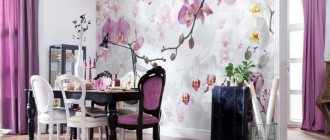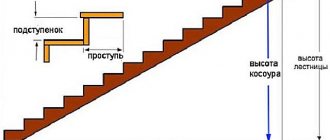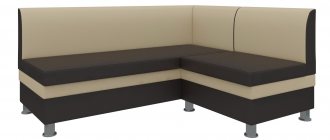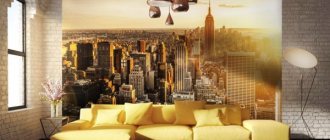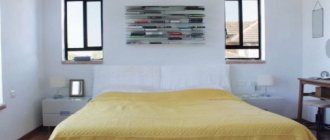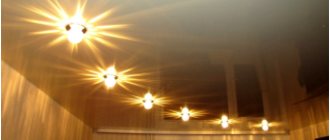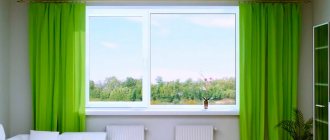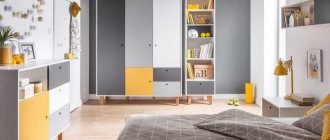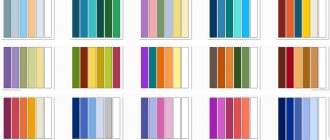Do-it-yourself wall bars technology
When it is not possible to purchase a ready-made sports complex, the question arises of how to make a wooden wall bars for your home with your own hands.
Wood for the simulator must be dried and seasoned. If a wall is being made for a small child, it is better to give preference to soft woods such as linden or pine. They are much easier to process compared to ash, beech or oak. To make a wooden wall bars with your own hands, you need to purchase an edged board 4.5-5 cm thick, 30 cm wide and at least 2.5 m long. Two side posts are made from it using a circulation machine. The surfaces of the elements are polished. Holes for crossbars are drilled in wooden blanks for racks at a distance of 20 cm from each other. The crossbars can also be cut out of wood or you can take ready-made cuttings from shovels no more than 4 cm thick. Next, all elements are final polished and treated with paint and varnish.
Now, based on the drawing of the wooden wall bars, the entire structure is assembled with your own hands. To do this you will need a set of fasteners. Next, the wall is attached to the wall using dowels.
Scheme of a Swedish wall that you can make yourself
It is much more difficult to make a metal wall bars with your own hands. To do this, you can take old pipes, stripping them of paint and rust, or purchase new products in the store.
Before assembling the structure, you need to draw up or download from the Internet a detailed drawing of a metal wall bars with your own hands, based on which to prepare all the necessary elements of a given size and in the required quantity.
A self-made children's wall bars can be equipped with various sports equipment, which can be purchased at sports stores. This option will be much cheaper than buying a ready-made complex.
Before purchasing a home sports complex, you need to familiarize yourself with the various options for wall bars, reviews of which will help you decide on a specific model. Here you should take into account the quality of the product, the dimensions of the structure, the mounting option and the possibility of additional equipment with sports equipment.
Ideas for decorating a gym at home
Unfortunately, most modern apartments are limited in square meters, and a children's room, as a rule, measures no more than 10 m
2
. But this should not be a reason to refuse to install sports equipment. Even in a very small room you can build a miniature sports corner.
If there is no room in the room for a wall bars, a small exercise machine can be installed in the doorway
- Option one. A wall bars are installed, hoops are mounted in the ceiling, and a basketball hoop is mounted on the wall. Additionally, you can hang a punching bag. Such a composition will take no more than 1 m
2, which will in no way affect the rest of the nursery area.
Metal wall bars attached to the ceiling, taking up minimal space in the room
- Option two is more advanced and consists of using transformable furniture, which can at the same time be a sports element and serve as a wardrobe, bed, or nightstand. Such furniture saves space well, and its modern design means that it fits perfectly into any interior.
Decorating a small sports ground at the head of the bed in a small room
For owners of an apartment with a large children's room, it is much easier to decorate a sports corner with their own hands. The absence of restrictions in square meters provides great opportunities, including the equipment of an entire sports complex. In addition to the main attributes, horizontal stairs, horizontal bars, an obstacle course, and various exercise equipment (treadmill, bicycle, etc.) are placed here.
Of course, such a sports corner will require significant financial investments, but the reward for the parents’ efforts will be the health and cheerful laughter of their children.
Large versatile sports area, in a dedicated room
Advice. By using your own imagination or inviting a professional designer to your home, you can design a children's sports corner in a specific theme, for example, a jungle or a pirate ship.
Designer decoration of a children's room with an interesting sports wall
How to make a children's sports corner with your own hands?
Even a craftsman without professional skills can cope with the manufacture of a primitive design. If you have worked with a hammer or electric drill at least several times in your life, then there will be no difficulties.
In the process we will need the following:
- boards;
- ropes;
- rope;
- fasteners;
- shovel cuttings;
- Sander;
- building level;
- electric jigsaw;
- milling cutter
It is necessary to first prepare the following materials.
Step one: first, cut the board to size (measuring the distance from the ceiling to the floor minus ten centimeters), and then sand it. Now these racks need to be connected with clamps and the location of the steps must be marked. Using a special attachment and an electric drill, we make holes along the marks, up to the middle of the depth of our boards. In order not to miscalculate the depth of the opening, you must first stick colored insulating tape onto the drill attachment.
The short parts will be part of a small monkey bars
Step two: now you need to take long posts and cut off an angle from them from the side of the wall for the baseboard.
This is what the cut should look like
Step three: next you need to connect these parts together. This is a crucial moment, because the level of reliability of the structure will depend on the strength of the connections. For such purposes, massive studs and nuts are used. In this case, openings must first be drilled for them; they must be located perpendicularly.
Four fasteners are enough
Step four: you need to fix the strips that will be steps into the prepared side parts. For safety, they are fixed to furniture confirmations. It is necessary to make holes in the end part and recess the fasteners inside. The fastening points can be hidden with decorative wood-like plugs or covered with paste.
This is what the parts connections look like
Step five: now you need to attach the structure to the wall to understand where to make the holes for the dowels.
We fix the base to the wall
Step six: after which it is necessary to make an additional ceiling fastening, because fastening to the ceiling is not enough, because over time the fasteners become loose. Therefore, we installed anchors in the ceiling, and then fixed rods with rings.
This is what a rigid fastening option looks like, in which the load on the wall bars will be correctly distributed
Step seven: after preparing the frame, you need to move on to the equipment. First we'll start with the rope ladder. It is necessary to prepare bars with a diameter of 3.5×2.5 centimeters. The length of the blanks should be about 30 centimeters. In this case, all edges must be processed using milling equipment and a grinding machine. On each crossbar it is necessary to place markings, retreating from the edge, five centimeters. There will be holes here that should be slightly wider than the rope.
It is necessary to drill holes according to the markings (otherwise the stairs will be uneven)
Step eight: now you need to take a rope and mark the location of the steps on it. Next, you need to put on the crossbar and tie a knot. In this way you can assemble the entire staircase.
We fix the ladder rungs on ropes
Step nine: now you need to secure the ladder on the ropes to the previously prepared hooks.
We fix additional equipment on the base
DIY children's sports complex
Swedish wall
The following tools and materials will be required:
- Round planks – 6-8 pcs. (you can take several polished cuttings from garden shovels).
- Wooden boards 5 by 15 cm – 2 pcs.
- Fastening elements (iron corners and screws are suitable).
- Glue.
- Sanding machine or sandpaper.
- Drill.
- Saw.
- Plane.
- Screwdriver.
- Gymnastic mats.
- Additional elements that the wall bars will be equipped with (these can be gymnastic rings, ropes, rope ladders, etc.).
Work order:
- Take 2 strong wooden beams, the dimensions of which should correspond to the height of the ceiling. Sand them thoroughly using a plane and a sander. Cosmetic sanding should be done using sandpaper.
- Using a screwdriver, make 12-14 holes in each beam. Please note that the holes must be parallel to each other on each block, because the crossbars will be fixed in them.
- Wooden boards or shovel handles intended for mounting crossbars should be thoroughly sanded using sandpaper.
- Each cutting is inserted into a hole in a wooden beam and securely secured with construction adhesive. Metal corners still need to be attached to each bar.
- Next, on the surface of the ceiling and floor, you should mark the points at which you plan to fix the structure.
- According to the previously made markings, attach the bars to their places. Check the stability and reliability of the structure.
- Coat the wood with a protective varnish.
Installation of horizontal bars, swings, gymnastic rings
Horizontal bars and swings are mandatory attributes of any sports complex for children's playgrounds. They will not be superfluous in the apartment.
The procedure for installing a horizontal bar for a wall-mounted children's sports complex is as follows:
For installation you will need 2 wooden blocks 70-80 cm long and 2 wooden crossbars. First of all, carefully sand their surface. We fix the bars to the wall with screws. The design of the horizontal bar should protrude from the wall no more than 65 cm, otherwise it will be unstable. We treat the wood with a protective varnish. At the last stage, it is necessary to check the stability and reliability of the structure
It is important that the horizontal bar can support the full weight of the child.
Installation of swings for children is carried out in the following order:
- To make the seat you will need sanded wooden blocks. They should be fastened together.
- The seat is attached to the sides with strong slats using screws and nuts. First, holes are made in the slats, through which nylon cords with a diameter of 6 mm will then be pulled. The entire structure will be suspended from them and then attached to an iron crossbar, which is installed in the corridor between two walls.
- A polyvinyl chloride tube is put on the nylon cord. The swing will slide along its surface when rocking. A cord is tied into a knot from one and the other edge of the tube.
- The mounting height of the swing should be adjusted depending on the height of the child, since it should be comfortable for the baby to sit on it.
Gymnastic rings for the sports corner are suspended on ropes or belts. The straps are fixed to the supporting crossbar of the frame. In addition to the rings, you can set up a gymnastic trapeze. It is mounted in the same way as the rings and is a wooden crossbar secured on both sides with ropes.
Making stairs
The procedure for making a wooden staircase for a sports corner is as follows:
- First of all, prepare strong wooden blocks, 1.5-2 m long. Sand them and varnish them.
- On the surface of the bars, drill holes with a diameter of 30 mm at equal intervals. They will serve to fasten the steps.
- The bars are secured to the floor and wall using reliable fastening pins 60 cm long.
- You can use shovel cuttings as steps or carve round round wooden steps yourself.
- The step bars are inserted into holes made in two bars and securely fixed with construction glue.
- Then you should definitely check the stability and reliability of the assembled structure.
If you want to make a rope ladder, then installation is carried out in the following order:
- Take two strong ropes with a diameter of 10 mm.
- Wooden crossbars, 30-40 cm long, are attached to the ropes in increments of 15-20 cm. Holes are first drilled in the crossbars through which the rope will be threaded on both sides.
- On both sides of the step, the rope is tied into a knot, which will fix the crossbar in one position.
- Check the stability and reliability of the stairs you have made.
Soft connections
In a home sports corner there is a lot of elemental hanging. And to decorate them you will need a nylon or polypropylene cord (linen, braided) with a diameter of 8 mm (for children), from 12 mm (for teenagers) and from 16 mm (for adults). If a twisted cable is used, all specified diameters will have to be multiplied by two.
Different projectiles of the home complex are tied with different knots:
The rings are tied with a scaffold knot (1), a Lynch loop (2) or suspended on a load loop (3).
The rope ladder is installed on the fishing knot (4).
As for the ring cables, it is best to secure them at the top of the console by threading them through vertical holes and securing them with a wedge made of hard wood. It is also recommended to leave a tail of 6-10 cm, which will need to be nailed to the upper cantilever edge.
( 55 votes, average: 5.00 out of 5)
How to hide pipes in the bathroom, kitchen, toilet?
Interior decoration of the bath
Related Posts
How to make a children's sports corner with your own hands
If you wish, it is quite possible to make a sports corner for the nursery with your own hands, rather than purchasing a ready-made one. This allows you not only to save money, but also to take into account as much as possible all the features and nuances of a particular room and those elements that you want to use in organizing the space.
It is important to decide what you want to include in the corner. As a rule, the main element is the wall bars, the installation of which is always carried out first as it takes up the most space
Approximate wall bars sizes for different age groups
DIY wall bars for a sports corner
In order to make a wall bars with your own hands, you will need:
- two beams, the height of which corresponds to the height from the floor to the ceiling of the room;
- six shovel handles;
- metal corners and screws;
- clothesline (as strong as possible);
- sandpaper;
- saw;
- drill;
- plane;
- glue.
You should start by adjusting the main beams, filing them to size and sanding them as smooth as possible with sandpaper. Then you need to make holes in them, symmetrical on both sides, so that their diameter matches the diameter of the cuttings chosen for the crossbars. If the height of the main beam is 3 m, then 12 crossbars are made at an equal distance from each other.
The standard equipment of the complex includes stationary and rope ladders, gymnastic rings, trapeze and rope
Since the cuttings are usually quite long, it is necessary to cut them into two parts. Then, having carefully coated the edges with glue, they are inserted into the holes
It is important not to proceed with attaching the structure to the wall until the glue has completely dried, otherwise there is a risk that you will have to redo everything all over again. Fastening is carried out using metal corners and screws
All that remains is to paint, open the structure with varnish and hang the rings.
Be sure to pay attention to which wall you are attaching the equipment to. Do not attach large elements designed for heavy loads to interior partitions
This is unsafe and over time the fasteners may fall off. A strong load-bearing wall is better suited for this purpose.
Activities at the children's sports corner are beneficial for children as young as 6 months.
How to make other elements for a children's sports corner with your own hands
The Swedish wall itself is not yet a sports corner. For its complete arrangement, additional crossbars, beams and other elements will be required. The easiest way is to make rings. To do this, it is enough to purchase two ready-made rings and a cable that is designed for such loads.
Using bars and a metal pipe you can make a horizontal bar, which is also very suitable for training. In this case, both wooden and metal elements must be painted. For this purpose, it is best to use modern compounds, for example, rubber paint. It is much more pleasant when in contact with the body and does not cause discomfort.
To protect the child from accidental falls, a mat is installed in the play area
When it comes to choosing colors for decoration, you can be guided by your preferences or the child’s hobbies. In addition, do not forget about the overall interior. For girls, bright colors are most often chosen, such as red, yellow or green. For boys, more muted: blue, gray, brown.
If you want to avoid painting sports equipment, you can opt for a synthetic varnish designed specifically for coating wood surfaces. Special compounds are also purchased for metal to preserve it and prevent corrosion.
Sports complexes for children are made from environmentally friendly materials in accordance with European standards
More and more parents are thinking about buying a sports corner for their children's room.
However, a set of shells made by yourself will be in no way inferior to a factory one, if you approach its manufacture with all the attention and responsibility. Regardless of which option you prefer: purchasing or making a sports corner yourself, be sure to involve your children so that they also take part in the selection and installation
Sports corner for children: basic requirements for the design and configuration of the set
Understanding why, and most importantly, for whom it is planned to be built will help you choose the best option for sports equipment and elements to complete the design of a sports corner for children.
The child’s age, physical characteristics, height and weight allow us to design the structure and subsequently develop a set of exercises for classes. Sports corners for the home can have the following classification:
- equipment for children from 1 to 3 years old; play-oriented;
- design for children 3-7 years old for initial physical development with play elements;
- classic gymnastics corner for children aged 8 to 14 years;
- a corner for keeping fit and exercising with sports and rehabilitation equipment.
It is quite possible to create a similar design yourself in a small area of a children’s room, especially considering that if you assemble it yourself, the cost will be 2-3 times less than a ready-made corner from the store.
The second important point in the decision to build everything with your own hands is the ability to control the child during his activities, gradually giving him the opportunity to study independently.
When starting construction, you need to clearly understand and see all the nuances of the location of the shells, their configuration and accessibility for the child. Having assembled an entry-level design, over time you can remake the physical education corner in accordance with the age and height of the child.
What does the sports corner consist of?
A playground for a child in an apartment can have different configurations. The possibility of installing elements depends on the well-being of the parents and, again, the free space in the apartment. In order to make a choice, it is necessary to take a closer look at the elements of the sports corner.
Table 1. Types of equipment for children's corners.
View, illustration Features
Horizontal bar This is a standard equipment that is available at all playgrounds. It is necessary for the development of back and shoulder muscles. In addition, the horizontal bar helps strengthen your arms. Children and adult family members like to periodically swing while holding this projectile with their hands. If there is not enough space in your apartment, then the horizontal bar can be fixed in the doorway - in this way you can save space
Important! Before letting your child near the horizontal bar, you need to make sure that it is securely fastened. Wall bars This apparatus will become a favorite place for active children to play. According to experts, if a baby climbs stairs with bare feet, he will not develop flat feet.
In addition, it improves coordination and helps strengthen the hands. As a rule, a wall bars are the main fixture of any children's corner. Rings In addition to the fact that long-term exercises on rings make your arms stronger, training helps improve the vestibular system, because many children prefer to hang their heads down on them.
Rope A rope is one of the devices that is problematic for adults to use in apartment conditions for its intended purpose (going up and down), because the ceiling height of the average room does not exceed 2.8 meters, and this is too small for a rope. However, the projectile is often installed even in small children’s corners, because this height will be just right for kids. As a rule, these are compact options that are easy to fix on the horizontal bar and then remove. Children hang and swing on such a rope with great interest.
Mat A mat is not only sports equipment, but also a way to protect a child from injury. At the same time, it is used to perform gymnastic exercises. You can find mats in a variety of designs at a sporting goods store. However, it is recommended to choose folding structures from several sections. If desired, the mat can be folded and increased in thickness. Some models can even be turned into a lounge chair if desired. Gymnastic mats will become a favorite gathering place for the whole family. Here you can arrange active games with your kids.
Trampoline This equipment has been causing a lot of controversy among experts and parents for many years. Of course, sweet potato trains muscles, balance, and also the vestibular system, but at the same time it creates a load on the spinal region. This, in turn, is harmful for children, so exercises on a trampoline should be dosed over time.
The projectile is a ladder that is in a horizontal position. Such a ladder is fixed at a certain distance from the floor to the ceilings.
Punching bag You can fix this projectile either on the ceiling or on the horizontal bar. Of course, boys are more likely to appreciate it. Inclined bench The bench is fixed to the rung of the ladder. It is necessary to strengthen the abdominal muscles. Suitable for both children and adults.
What elements are best to choose for a home sports complex?
It should be borne in mind that all equipment installed in a children's sports corner should not only be fun, but also a way to strengthen muscles. However, the child’s opinion should also be taken into account here, especially if he is already involved in any section, because every sport requires intensive training of certain muscle groups.
So, if you are raising a future boxer, then be sure to install a punching bag in your apartment. If your child is interested in basketball, then you need to install a special ring and purchase a ball.
For girls who are interested in choreography, it is recommended to install a full-length mirror, as well as machines near the wall.
For small children, a corner with a slide would be an excellent solution.
Early development sports complexes - sizes, differences, pros and cons
Photo: blog.danilova.ru
Choosing the localization of a children's corner
Place the play platform as close to the house as possible. This will allow you to continuously monitor the child’s actions and help control the situation. Older children need less care, so set up a playground for them away from parental supervision - alternatively, behind the house. A third of the perimeter should be located in the shade. If your summer cottage is deprived of tall plants, make a canopy. It will protect children from excess ultraviolet radiation. Do not set up a playground in places where there is excess humidity and there is no direct exposure to sunlight. Cover the ground with artificial turf or mats. Fence the corner with a fence so that the children feel like full owners of the territory.
The space of the children's corner in the country can be covered with a soft covering
Safety. The first thing parents should think about is the safety of their child. Make sure that your son or daughter is protected from the scorching summer sun and drafts. All site structures must be firmly fixed and not contain sharp corners and sides, as they are likely to cause injury. The paint used in the work must be carefully selected, because this chemical contains many toxic components. So that children can run barefoot, sow the perimeter of the play area with a lawn carpet or fill it with sand. Constantly check the foundation for glass or rusty nails.
The area near a reservoir or pond is not at all a suitable place for a corner, since a child could inadvertently “dive” into the water. We also do not recommend placing the complex on an inclined plane (slopes, slopes)
Take the trouble to level out the hills. Let the play complex be located away from the shed with tools and other objects dangerous for children. There should be no sharp rods, protruding nails, toxic substances or poorly sanded wood with splinters.
Fence the children's corner at the dacha with a fence for safety.
It is better to shade the sandbox with a canopy so that the child does not overheat while playing.
How to make the complex yourself
If you don’t have the necessary funds or you simply have the necessary carpentry skills, you can try to build a country children’s playground with your own hands.
- You need to start by installing a swing, to which gradually in the future it will be possible to add different elements.
- Step by step you can create horizontal bars, a sandbox, and a children's hut.
- For the construction of a children's sports complex, you can use:
- boards;
- metal posts;
- plywood;
- thick canvas fabric;
- jute rope.
Remember, a sports complex for a dacha, built independently, will be unique. In addition, it can fit under absolutely any terrain and any free space in a summer cottage. Of course, this is one of the main advantages of a homemade sports town over a purchased one.
Option for a homemade country sports complex
Don’t forget about the playhouse, which is an integral attribute of any children’s playground. You can also make it yourself and then fill it with furniture and a number of colorful accessories. Playing in such a “home” will captivate children for a long time and allow parents to go about their business.
Installation and installation of a finished wall bars
So, the whole structure is ready. All that remains is to install it on the spacers. To do this, we screw spacers into the upper and lower parts of the sidewalls of the wall bars, install the structure in the desired location and then unscrew the spacers to the limit, ensuring the absolute immobility of the structure.
It is important to remember that it is advisable to periodically check the spacers and, if necessary, tighten the nuts. And for those who still want to install a ready-made corner by attaching it to the wall, we inform you:
And for those who still want to install a ready-made corner by attaching it to the wall, we inform you:
- It is better to install the structure to a brick wall using dowels;
- To a concrete wall - on anchors;
- Plasterboard walls are just spacers.
And be sure to equip the children's sports corner with soft mats. You don't have to worry about possible injuries to your baby and his friends.
So, having worked with our hands and heads, we get a tool for fun children's games and useful pastime. Believe me, a couple of days spent, and small physical expenses will pay off when you watch the happy face of your playing baby.
Sports ground coverings
For safe play and sports, it is necessary to provide a shock-absorbing coating. Among the existing options, the following deserve attention:
• soil mixtures (material from clay, crushed brick, lime is poured onto a sand cushion);
• artificial grass 5-7 cm high (any variety made from polyethylene, polypropylene, polyamide will do);
• sports lawn (low-growing grass of special varieties);
• rolled rubber material;
• acrylic-based self-leveling polymer coatings.
If you are considering a budget option, then an ordinary sand cushion laid on a leveled area will do.
No. 4. Methods for installing a children's sports complex
When choosing a sports corner for your apartment, do not forget to also take into account the nuances of finishing the room where the equipment will be located. If suspended ceilings are installed in the room, then it will be impossible to use some types of complexes. Please note that it is necessary to mount the wall only along the load-bearing wall.
Depending on the mounting features, children's sports complexes are:
- Spacers are installed in the spacer between the ceiling and the floor. They are often L- or T-shaped, but can also be non-standard. This complex is an excellent option for those who live in a rented apartment or are planning to move it soon, since there is no need to drill the walls. In terms of stability, such corners are ideal, but there are limitations. In order for the complex to be fixed, the ceiling must be rigid and reliable, i.e. if the room has suspended or suspended ceilings, then such a model of the complex will have to be abandoned. Exceptions are those cases when you took care of installing special mortgages in advance at the stage of finishing the ceiling;
- wall complexes are attached to the wall with anchors or bolts. It must be durable and monolithic. It is best to mount it to a load-bearing wall. Installation to plasterboard partitions is prohibited. Such complexes, as a rule, take up a minimum of space, and are perfect in cases where a suspended ceiling is installed in the room;
- hinged structures require fastening to the ceiling. An excellent option when square meters are very limited. This group includes ropes, horizontal bars, gymnastic rings, rope ladders, monkey bars, swings and other devices;
- Autonomous floor systems are usually designed for children under 4 years old. The area occupied by such a corner may vary. The layout is also different. Many models are produced folding, and when there is no need for them, they can be compactly stored in the pantry. The most functional samples can sometimes be turned over so that the child does not get bored with the same elements. The advantages of such complexes are obvious, but there is one drawback, but a significant one - the high price, especially considering that the corner is only suitable for children under 4-5 years old.
We hope that now everyone is convinced that a sports corner can be installed in any room. Now it’s time for the most interesting part – choosing a set of sports equipment.
Where can you install a sports corner in an apartment?
You have decided to purchase a sports corner, and here it is, the first question you ask yourself: “Where to install it?”
This problem needs to be solved individually for each home, taking into account its size and layout, but there are several rules that it is advisable to take into account
- To install a sports corner, a room without a through passage is ideal, because this way no one will disturb anyone during classes - neither a child cheerfully climbing on the rungs to visiting guests, nor a mother or father passing onto the balcony for their child.
- Ideally, it is best to install a sports corner in a children's room, where the child is well oriented and feels comfortable. Of course, if instead of a full-fledged sports complex you have purchased just one horizontal bar, then the best place for it is a doorway, where the horizontal bar can be hung higher and higher as the baby grows.
- The vast majority of complexes consisting of wall bars and other additions have a spacer design, that is, they are attached between the floor and ceiling according to the principle of a jack. This mount is very strong and absolutely safe, all legs have rubber gaskets and will not damage the surfaces they rest against, and there is no need to drill anything. However, if the room has suspended or suspended ceilings, then the spacer mount, of course, is not suitable, and in this case it is better to choose a sports children's corner with a wall structure. Such a complex is attached to the wall with reliable bolts, but in terms of mobility it is inferior to structures with a spacer installation, because they are not so easy to disassemble and reassemble.
No. 5. Children's sports corner equipment
The set of elements that will be included in the sports complex depends on many factors. These are the age and preferences of the child, the area of the room and the height of the ceilings, as well as the budget. The basic equipment is considered to be a wall bars, a horizontal bar, rings and a rope. You can combine various elements to your liking - manufacturers meet the buyer halfway in this matter.
In children's sports corners, as a rule, the following elements are used:
- The wall bars are permanently attached to a vertical surface and are intended for climbing and gymnastics. A similar element is suitable for children from 1 year old, but, naturally, in a simplified version with frequent crossbars of small diameter. For children from 4 years old, you can take a universal wall bars, and as the little person grows up, add new elements to it;
- The horizontal bar, as a rule, complements the wall bars, but can be attached separately. Kids will enjoy hanging on the horizontal bar, swinging and stretching their spine, which is very useful. Teens and adults can use the horizontal bar to strengthen their arms, back, and abdominal muscles by performing pull-ups. The horizontal bar takes up minimal space, but there should be about 1 m of free space in front of it. If there is very little space in the apartment, the horizontal bar can be placed in some doorway;
- the rope can be attached to the horizontal bar or to the ceiling. Rope climbing strengthens the muscles of the arms, legs, back and abs, bringing great pleasure to children. The rope can be equipped with sports walls for children from 2 years old;
- gymnastic rings on cables are also attached to a horizontal bar or ceiling and are designed to stretch the spine and perform exercises such as inversions. Children especially like this apparatus; they love hanging and swinging on the rings;
- A trapezoid is a horizontal bar suspended by two ropes. It can also be rolled on and flipped over, and some children use it as a swing;
- A ladder is a ladder that is installed at a height horizontally or at an angle. Can be attached to walls, ceilings or racks of the complex. Allows kids to train their arm muscles, because to move on the monkey bars they will have to lift their own weight. Handlebars are often equipped with swings, rings, rope, punching bag and other elements;
- an inclined bench is attached to one of the bars of the wall bars and is designed to strengthen the abs. This apparatus is more suitable for teenagers, although it can be used by kids as a small slide;
- A rope ladder develops coordination and dexterity much better than a regular stationary one, and also massages the feet. Going up and down such stairs is not easy, but for children it is a special pleasure;
- a rope climb is a mesh of rope that allows you to simulate a climbing wall at home;
- A bungee disc is a rope with a seat at the bottom that can be used for both riding and climbing. It takes up little space, but for normal use there should be enough space around the projectile;
- a punching bag is attached to the ceiling, horizontal bar or monkey bars and will help the little boxer practice basic punches;
- a basketball hoop, as a rule, is not included in complexes, but can be installed separately, for example, on the front door, wall or end of a bed located on the second tier;
- the hammock and swing are more intended for play and relaxation; they are included in fairly spacious complexes.
Some advanced complexes may include some other elements.
Place, shells and mount
When choosing a prototype to replicate a sports corner or designing your own locally at home, you must first solve 3 problems:
- Find a place in the house for the corner;
- Choose sports equipment;
- Determine the method of attaching the complex to supporting structures.
Place
Is it even possible to set up a sports corner at home that will be beneficial, determined by the availability of free space for it in the house:
- For a preschooler - at least 1.2 free walls in length (for 2 equipment: a Swedish wall and a climbing frame) and at least 80 cm in width of the floor in front of it that is not systematically used. Ceiling height – any.
- From first graders to the onset of puberty (10-12 years old) - at least 1.6-1.8 m of wall and 1.2 m of free floor in front of it. Ceiling height – from 2.5 m.
- For teenagers and adults, for easy warm-up - walls from 2.2-2.5 m and the floor in front from 1.5-1.7 m. Ceiling height from 2.8 m for people of average height and from 3.2 m for tall people (above 180 cm).
If only one person, or several in turn, will be practicing on the apparatus, the required wall space can be “bent” by 90 degrees and the complex can be placed at an angle in the corner of the room.
In this case, the required length of the free wall is divided according to the width of the shells (at least 60 cm per one). The free floor in front of the complex will need a square with a side equal to the width of the widest projectile. If the rings and/or trapezoid are hung on a console (see below), at least 1.2-1.5 m of floor outside of it must be freed from regular use. Large and/or older teenagers and adults practice on apparatus in the home sports corner only one at a time (see above). Preschoolers and elementary school students can and should have company; let's say with friends. This develops the spirit of sportsmanship, competitiveness and the habit of fair, benevolent competition. In this case, the entire complex is located only in a line for which the length of the free wall is required:
- For preschoolers – from 1.6 m.
- At the age of primary school - from 2 m.
- For teenagers of average build up to 14-15 years old - from 2.2 m.
The width of the free floor space in front of the complex will be needed as much as for single classes.
Note: the requirements listed above are explained by the need to avoid both mutual injury and overloading of load-bearing building structures.
Equipment
The minimum composition of a home sports corner includes the following. shells:
- Swedish wall;
- Height-adjustable gymnastic bar (horizontal bar);
- Rope ladder with hard steps;
- Rope;
- Damping mat.
It is highly advisable to supplement the sports corner for schoolchildren with gymnastic rings (item 1 in the figure):
Basic and additional equipment for a home sports corner. Methods of attaching a sports corner in a house (apartment) to building structures
In general, all children will find the climbing net, pos. 2, if only there is room for it. For a house/apartment with ceilings from 3.2-3.5 m, if several people are training on apparatus, it would be good to arrange a platform with a fence above the corner, pos. 3, a kind of podium for the strongest and most dexterous. A sports corner with a pedestal perfectly develops in children a sense of self-esteem without painful conceit and healthy competition.
Fastening
It is possible to mount a children's home in the spacer between the floor and the ceiling (item 4) in the figure if the ceiling is concrete and the floor is laid with laminate, etc. sufficiently durable slab material without lag on the self-leveling leveler. Otherwise, you risk serious injury to those involved due to a sudden collapse of the entire structure of the complex.
The most reliable way to fasten the sports corner structure to the wall is with anchor bolts, pos. 5, but hammer and pick at the wall; Perhaps, just after renovation, you don’t really want something. Next, we will look at how a children's sports corner for preschoolers and primary schoolchildren can be absolutely securely attached to the wall in an apartment at just 2 points.
About the crossbars
If the sports corner is used by people of different ages, then the first question that arises is the diameters of the crossbars on the wall bars and horizontal bar. Children need bars 24-30 mm thick, otherwise they won’t get a good grip. For teenagers and adults – 40-42 mm, taking into account the inertia of their body mass. Using the method described below, it is possible to glue crossbars for a wall with a diameter of 26-30 mm from inexpensive packaging plywood, which for many years can withstand a regularly exercising man weighing 75 kg.
The crossbar for the horizontal bar experiences many times greater loads. A possible solution described on the Internet is a wooden rod pressed into a thin-walled steel pipe. But, firstly, thin-walled pipes made of high-strength steel are expensive and cannot be cut into meters at the buyer’s request. And most importantly, how to tightly push a wooden block into a thin pipe at home? You cannot use a jack or wedges with a stop - the opposite end of the pipe will be crushed. If you plant it loosely on glue, it won’t have the required strength.
The output is a crossbar with a diameter of 30-35 mm, glued from 3 layers of 12 mm plywood with a width of 36 mm, see below. The middle layer is 2 strips 12 mm wide. When gluing, a steel threaded rod M12 with tails protruding outward by 100-120 mm is inserted between them. A re-glued bag with a cross-section of 36x36 can be perfectly turned on a metal lathe with a diameter of up to 35 mm (an aluminum tube is put on the tail inserted into the spindle so as not to crush the thread). When assembling the horizontal bar (see below), the wooden ends of the crossbar are glued into the sockets of the consoles, and immediately, before the glue dries, the assembly unit is tightly tightened with nuts and washers from 40x2 mm. The excess steel core is trimmed off after the glue has completely cured. Of course, you can’t spin the sun on such a crossbar. Exiting by force with one arm will also not work: the maximum length of the crossbar for a weight of up to 80 kg is 1.2 m. But a man can withstand lifting 75 kg by inverting 4-5 times repeatedly and systematically.
Swedish wall
One of the main elements of the home gym
To make a wall bars (or simply a sports ladder) you will need:
Side bars made of wood. The height of the material can be arbitrary (depending on the height of the ceilings in the children's room), but, as a rule, the height of the finished staircase is 2.5 m. In our case, the finished structure will be installed on spacers, and therefore accurately measure the distance between the floor and the ceiling minus 10 cm. This indicator will be optimal for your stairs. The width of the beams should be from 10 to 15 cm, and their thickness should be 2 cm or more.
When choosing wooden blocks, you should not save money - buy the highest quality wood
- Wooden round slats (diameter - 2.5 cm; length - 40 cm; the quantity is calculated based on the height of the sidewalls divided by 30. In this case, the number 30 is the step length of the stairs).
- Sandpaper.
- Wood glue.
- Drill/driver for drilling holes in the sides.
- Construction or simple pencil.
- Self-tapping screws (optional for securing the steps of the stairs in the sidewalls).
- Roulette.
- Varnish for treating wooden surfaces.
Stages of staircase manufacturing
- After the wooden blanks have been carefully processed, using a tape measure and a pencil, we mark on the sides the places for drilling holes for the crossbars.
- Using a drill-driver using a special attachment, we form the joints of the crossbars with the sidewalls.
- We coat the finished round slats-steps well with wood glue and drive them into the resulting grooves.
- Thus, we assemble the entire structure and leave it until completely dry.
- If desired, you can additionally secure the steps in the stairs with self-tapping screws on the outside of the sidewalls.
- After two or three days, cover the entire staircase with a thin layer of varnish. This will add color and additional smoothness to the structure.
Rings
In order for the child's wall bars to be as complete and functional as possible, all that remains is to equip it with rings and a rope ladder. Step by step creating a sports complex for the baby, for now let's move on to making rings.
For this we need:
- Plywood sheet 75x75 cm - 2 pcs.
- Construction compass.
- Wood glue.
- Press or bolts.
- Jigsaw.
- Milling machine.
- Rafters.
- Drill-driver.
Step-by-step production
- We draw each sheet of plywood into six equal squares and cut it with a jigsaw.
- We glue each of the six squares together with wood glue, laying them one on top like a sandwich. You should get two such plywood “sandwiches”.
- We send both structures under the press or securely tighten them in the corners and center with bolts, leaving them for a couple of days until completely dry.
- As soon as the wood dries, we draw rings on the plywood, the inner diameter of which will be 18 cm, and along the outer edge - 20.5 cm.
- Cut out the rings with a jigsaw.
- By the way, there (if you don’t have a milling machine) you can ask your friends to give the rings a circular cross-section along the entire perimeter of the workpiece.
- All that remains is to sand the rings and coat them with varnish.
- Now in one of the sides of the horizontal bar we make holes with a drill at a distance of 40 cm from each other.
- We pass the rafters through them and hang the rings at the desired height. By the way, it is better to purchase good rafters at a sports store. After all, they play an important role in ring training, taking on the entire load. If you can’t afford it, then limit yourself to any rope that is convenient for you. It’s inexpensive for you, and it’s fun for your baby to be a monkey.
Nuances of completing a functional corner
For a sports corner for children in the apartment, various functional options are provided. Consider the following elements:
- the basis of the complex is the Swedish wall;
- horizontal bars, rings and ladders suspended horizontally will be a useful addition;
- even for the little ones you can use a swing;
- All kinds of rope devices have a wonderful effect on all muscle groups;
- the ball and basketball hoop promote the development of motor skills and coordination;
- Punching bags and mats are suitable for completing the complex.
Configuration diagram using the example of a separate model
For your information! If there are no mats, then mattresses can be laid under the horizontal bars. This will ensure the safety of your children. In addition, it is worth taking care of rounding sharp corners, as well as putting plugs on fasteners.
